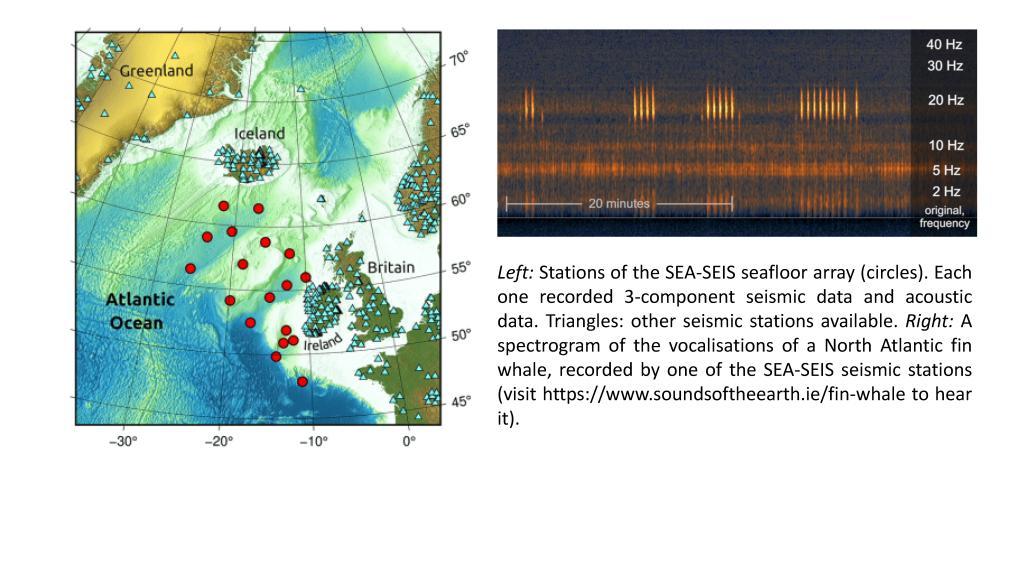
Lead supervisor: Sergei Lebedev, Earth Sciences
Co-supervisor: Jennifer Jackson, British Antarctic Survey
Brief summary:
Use biophonic, geophonic and anthropophonic signals in massive new seafloor datasets to study great whales’ environment and migration patterns and Earth dynamics.
Importance of the area of research concerned:
Seismometers and hydrophones deployed on the seafloor record a new kind of data that present unique new opportunities. They can be used to locate and track baleen whales, to quantify anthropogenic noise pollution and how it is likely to be affecting the whales, to locate nearby earthquakes and to study the deep Earth below. This type of data is becoming increasingly common, and effective methods are required to make use of the wealth of information present in them.
Recordings of the vocalisations of the baleen whales, in particular, offer valuable information on their populations. They have been made previously by hydrophones, but these are often short-term or discontinuous. In 2018-2020, the project SEA-SEIS (www.sea-seis.ie) collected 19 months of continuous, hydrophone and 3-component seismic data on the North Atlantic seafloor. The frequency range of the data comprises the entire ranges of the Blue and Fin Whale vocalisations. The data show clear whale song recordings and can be used to locate and track the animals. The SEA-SEIS network stretches across over half the width of the NE Atlantic and offers unique new evidence on the abundance and migration patterns of the whales.
Project summary :
Data from ocean-bottom seismometers and hydrophones can be used to locate and track baleen whales. The project supervisor and collaborators have recently collected unique new data in the North Atlantic (www.sea-seis.ie). State of the art AI/ML methods for the detection of whale vocalisations and other signals in continuous waveform data are available from the co-supervisor and collaborators. New methods for the detection, discrimination and use of the signals will also be developed and applied in this project to the large dataset of continuous data. The analysis will provide important new evidence on the whales’ behaviour, abundance, and migration patterns, as well as insights into the Earth and ocean dynamics from other geophonic, anthropophonic and biophonic signals. The project will present excellent opportunities for outreach and public engagement (https://www.soundsoftheearth.ie).
What will the student do?:
The dataset available for this project is a treasure trove of new data, but detecting and identifying whale vocalisations and other signals in the very large data volume is a challenge. Vocalisation examples for different species are available from previous studies and will be used as templates. AI and ML tools will be used to detect vocalisations in the continuous data and match signals to species. The student will first use ML to detect fin whale vocalizations and other signals and build a catalogue of them. Second, other whale species will be identified systematically. Large datasets will be assembled and used for the quantitative analysis of whale abundance and migration patterns. The work will be conducted in collaboration with marine mammal acoustic experts at the Scottish Association for Marine Sciences and, possibly, the Alan Turing Institute. The student will, first, obtain important new information on the populations of species known to inhabit the North Atlantic and then, perhaps, make some unexpected discoveries, given the unique nature of the data.
References - references should provide further reading about the project:
Lebedev, S., R. Bonadio, M. Tsekhmistrenko, J.I. de Laat, C.J. Bean, 2021. Seafloor seismometers look for clues to North Atlantic volcanism, EOS, 102, https://doi.org/10.1029/2021EO159380.
Vickers, W., Milner, B., Risch, D. and Lee, R., 2021. Robust North Atlantic right whale detection using deep learning models for denoising. The Journal of the Acoustical Society of America, 149(6), pp.3797-3812. https://tinyurl.com/r9umbsxr
Dréo, R., Bouffaut, L., Leroy, E., Barruol, G. and Samaran, F., 2019. Baleen whale distribution and seasonal occurrence revealed by an ocean bottom seismometer network in the Western Indian Ocean. Deep Sea Research Part II: Topical Studies in Oceanography, 161, pp.132-144. https://core.ac.uk/download/pdf/157596867.pdf
Applying
You can find out about applying for this project on the Department of Earth Sciences page.